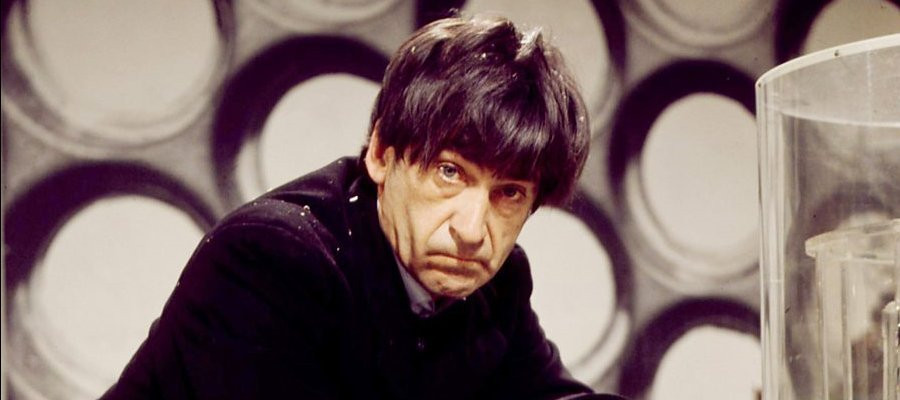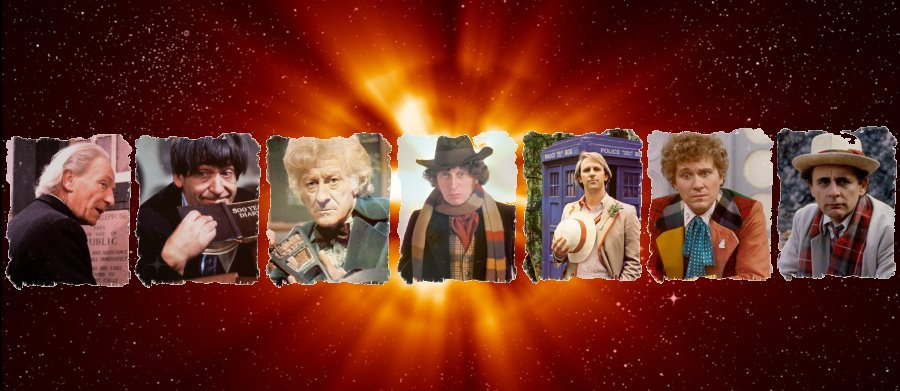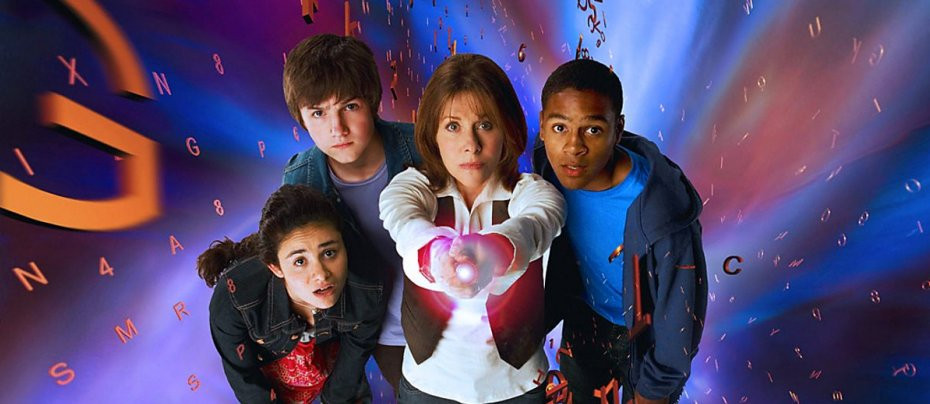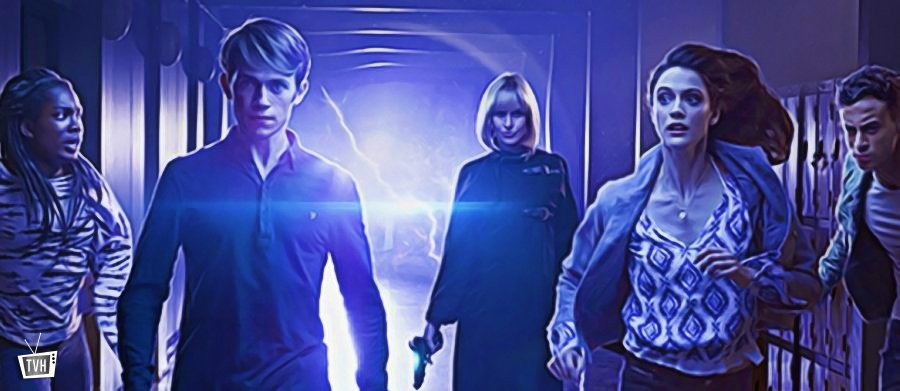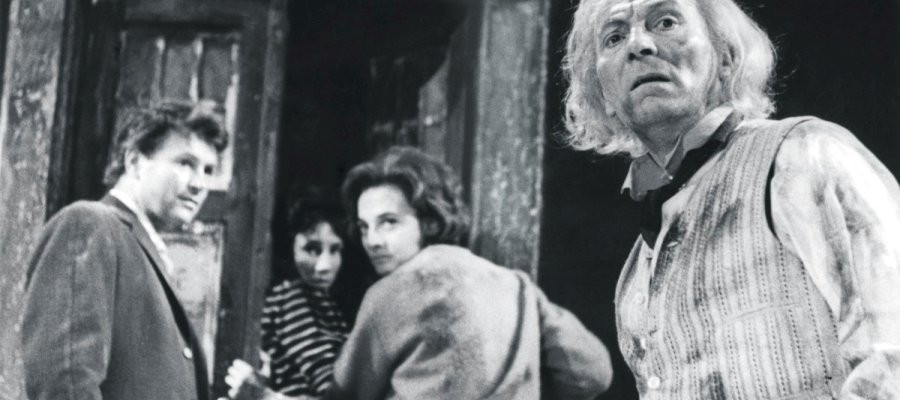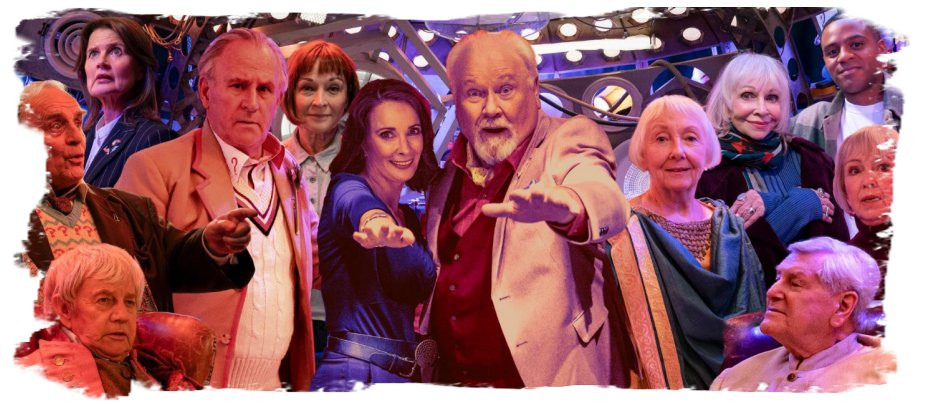Lost and Found:

Digging up the past in/of the Doctor Who serial 'The Tomb of the Cybermen'
This article centres around the 1967 Doctor Who serial 'The Tomb of the Cybermen' by Kit Pedler and Gerry Davis. This serial features archaeologist characters and is of particular interest since it was lost from the BBC Archives and later found; therefore, we ourselves can be put in the role of archaeologists or, more accurately, historians, as we see how, for a large part, the serial works visually, alongside sound, under the directorship of Morris Barry.
However, before delving into a discussion of Doctor Who, it is important to define what is meant by ‘archaeology’. A Web search reveals that the word archaeology comes from the Greek archaeo, meaning ancient, and logos, meaning word or study, so it translates as ‘the study of ancient things’. The discipline is concerned with examining and explaining the past and human behaviour through examining human remains through activities such as digs (though in SF these activities can be the study of alien lifeforms). There is a similar study of ancient, or, more accurately, past television treasures, digging up the past where, for instance, many 1960s Doctor Who’s have been missing, and in some cases found, but these would be labelled the work of archivists, collecting them, and historians, analysing them, rather than of archaeologists.
Richard Molesworth (DVD Infotext) details the history of how 'Tomb of the Cybermen' came to be missing and later recovered. The BBC wiped the transmission masters of all 4 episodes on 29 September 1969. BBC Enterprises had the story for sale until 1974. The film proofs were junked years later and by 1978 the BBC no longer held this serial in any shape or form. 'Tomb' was most sought after and in January 1992 film copies of all 4 episodes were returned to the BBC from RTV in Hong Kong.

After a pan from left to right taking in the landscape of the planet Telos and the spacecraft, 'Tomb' concerns an archaeological expedition 'searching the universe for the last remains of the Cybermen'. As Gary Hopkins observes, this expedition is akin to Egyptian archaeology and this is highlighted in the Target novelisation, first published in 1978, where there is a comparison with ‘the tombs of ancient Egypt’ (1992: 8) and where the motifs of Cybermen on the walls are akin to ‘hieroglyphic figures’ (1992: 28). In the script book, it is revealed that script editor Victor Pemberton ‘imagined the Tombs to be a variation on the Pharoah’s tomb’ (McElroy 1989: 12). In the televised version, upon seeing the tombs, Klieg says: 'This is a unique archaeological event. It would be such a pity to miss it'. The recovery of this serial was also an attempt by archivists to bring the remains of the Cybermen to the television viewer who would not want to miss it.
It is important to analyse the visuals in the serial which is the work of historians. These are apart from the scenes which need to be described as one cannot understand exactly what is going on in the audio of the Jon Pertwee narrated soundtrack, recorded before the serial was recovered but released afterwards. Catherine Johnson (2005) argues that practitioners such as Nigel Kneale and Rudolph Cartier emphasised TV's potential as a visual medium with a closer relationship to cinema than radio. Johnson argues against John Ellis' (1982) glance theory where television was watched with a glance, as opposed to with the gaze of cinema, while people were doing other things such as household chores. Ellis argued that sound was of primary importance to television and that the image was bare though he noted that there were exceptions such as science fiction programmes. Here there is the importance of the recovery of missing TV episodes with their visuals which are watched attentively and not solely sound.

I have previously noted (O'Day 2014) the emphasis on visuals in 1960s Doctor Who serials going all the way back to the first revelation of a Dalek in 1963 and the point that the idea of looking was noted in dialogue just as Johnson argued this in relation to The Quatermass Experiment (1953). I also pointed out that in 'Tomb' there were shots of the tomb and of Cybermen emerging. But the idea of looking is again highlighted in dialogue: 'Behold gentlemen, the tombs of the Cybermen', 'look' etc. Professor Parry indeed takes pictures with a camera and it is the visuals accompanying the dialogue, for instance of an ascending shot of the frozen tombs and soon after of the Cybermen awaking, that are important to us.
The use of the camera is further key to 'Tomb' through the use of zoom in shots to figures for dramatic effect. This is the case, for instance, at the end of the first episode where there is a fast zoom in to a close-up of a Cyberman, even though this would turn out to be simply a model. Again, in the final episode there is not only a zoom-in to a shot of Toberman under the Cybermen's control but towards the end there is another zoom-in shot of the Cyber-controller which confronts the Doctor and Jamie in the control room.

There is also a striking visual after Captain Hopper reveals that the ship has been sabotaged and that their chances of getting off the planet have been wrecked. There is a zoom up to a relief of a Cyberman head on a wall followed by this being replaced by another image of a Cyberman face and a zoom out and down. It is the combination of Captain Hopper’s statement with this image that is key. The reliefs provide a sense of dread, reminding the television viewer that this is the Cybermen’s base of which the Doctor and his companions and members of the archaeology expedition are confined. When the camera comes back down to the party Viner calls it a ‘sinister building’ and says they would not survive for 72 hours. The dominating quality of the Cyberman reliefs against the isolated party was highlighted in the Target novelisation: ‘Viner looked around at the bright walls where the Cyberman bas-reliefs still stood stiff and huge, dominating the humans below’ (1992: 63) and ‘They stood isolated in the vault of the metal room, looking up at the Cyberman figures…across the walls’ (1992: 66). There is just a face at this point in the televised version mentioned in the script book: ‘The unchanging faces of the Cyberman motifs stare down at them from the wall’ (McElroy 1989: 70). But it is also important to see the camera technique of zooming up to one face and zooming down from a dissolve of another, accompanying dialogue, in the televised version.
There are, furthermore, key shots in the third episode which underscore the gigantic quality, and strength, of the Cybermen. The first of these begins with the camera focussed on a drawing of a Cyberman on the ground and then moving upwards to take in a shot of the Doctor, Jamie, Professor Parry and Klieg from behind with Cybermen standing in front. There is a zoom in to the human(oids) occupying the lower left of the frame and two Cybermen standing in front.

The effect that this has is that it makes the human(oids) appear small and vulnerable. The Doctor, Jamie, and Professor Parry (with Klieg not in shot) are then presented sitting on the ground, prisoners of the Cybermen, in the middle of the frame, and now seen from the front. On each side of the frame there is part of a Cyberman looking at them, seen by us from behind. The effect of this is that again the Doctor and company seem smaller and vulnerable. This shot works in tandem with the audio where the Cybermen are telling the human(oids) that they will be frozen and converted into Cybermen.
There are also visuals connected with Toberman. For example, he opens the door to the base in the first episode and closes it, electrocuting himself at the end but there are also scenes which are even more dramatic when seen on television. In the third episode, there are shots of Cybermen picking him up, showing how strong the silver giants are, and controlling him with there being an effect of a spark reaching to his head. Furthermore, later in episode four, Toberman's strength, after being partly converted, is highlighted when he picks up a Cyberman and brings it crashing down on the control panel. Later still, with his hands Toberman smashes the chest unit of a Cyberman with foam oozing out of the creature.
The Cybermats are moreover represented, for the most part, visually. In the first episode, Jamie says that it is as 'dead as a stone' and in the second episode, Victoria says 'it's a fossil'. The Doctor replies that it's certainly 'not a fossil' and the Cybermats are later represented as small metallic creatures with teeth (as would have been seen in stills) with a sinister bleeping sound also associated with them. Victoria puts one in her bag and there is a focus on this bag after Victoria puts it down, and later there is a zoom-in on the bag with something evidently moving inside it, generating suspense (see Beech, ‘Tombwatch’), before we see the full horror of Cybermats advancing on individuals and on people in number. These points are present in the Target novelisation, in the script book, and on the Jon Pertwee narrated soundtrack, however we see how a technique such as a zoom-in on Victoria’s bag is used in the television version. Indeed, there is also an Extreme Close Up of a Cybermat before it gets ready to attack Callum (see ‘Time Space Visualiser’ blog).
There are types of close-up in the serial such as of Klieg, focusing us on character. On top of that, a very famous scene in 'Tomb' comes in the third episode where there is a pause in the action and a very tender moment between the Doctor and Victoria after the Doctor wakes up and goes over to her. The Doctor asks Victoria whether she is happy travelling with him and she replies in the affirmative but recounts her sadness at the death of her father by the Daleks in the previous serial, 'The Evil of the Daleks' (1967). There is a type of close-up of Victoria as she recalls this, with close-ups in television used to capture the emotions of characters. This highlights the benefits of having the serial in its original state where dialogue and camera work function in tandem.
There are furthermore instances where the screen fades to black, this being a common technique, deriving from theatre, for indicating a change of scene. In the first episode, there is such a fade after the Doctor says with a chuckle that they should give Klieg the chance to show off his archaeological skills as he loves to see the experts at work. The next scene is of Kaftan’s party entering the room with the revitalising equipment. Another such instance is in the final episode when the screen fades to black after Klieg takes his weapon and descends through the hatch. Klieg will confront the Doctor and Toberman who are then shown in front of the tombs.

There are also, however, moments which would be apparent simply by listening to the audio track of 'Tomb'. For example, scenes are joined together. In the second episode, a party, which includes the Doctor, has descended below ground to where the tombs are, while Victoria has remained above ground with Kaftan. Beneath ground it is 'too cold to remain for too long'. Klieg makes the point that this is so unless they find someway to warm things up. There is then a cut to Victoria and Kaftan with Kaftan saying that Victoria’s coffee, which has been drugged must be cold by now and Victoria noting that it is much warmer in the room now before falling to sleep.
There is also a connection between the characters of the Doctor and Victoria and between Klieg and Kaftan through mirroring dialogue. In the third episode, the Doctor asks Klieg if he ‘still think(s) (he) can bargain with the Cybermen’ to which Klieg responds that he needs to be in a ‘stronger position to bargain’. In the final episode, the Doctor again says to Klieg ‘Do you still think you can bargain with the Cybermen?’, to which Klieg responds ‘Certainly. This time on our terms’. And later Victoria asks ‘Do you really believe you can bargain with those terrible Cybermen’. Kaftan answers ‘That is our concern, not yours’ to which Victoria states ‘I’m talking to him, not you’. Klieg again says: ‘They will have to agree to our plan’.

'Tomb of the Cybermen' is a Doctor Who serial which was missing but found sometime ago. The above discussion shows the importance of finding the remaining missing Doctor Who episodes and analysing their visuals, combined with sound. Various methods have been applied to them such as quite a long time ago Loose Cannon reconstructions (putting the audio tracks to stills), recovering tele-snaps, largely by John Cura (such as printed in DWB, in the Doctor Who Magazine specials, and in the Doctor Who Classic Comics), animating the missing episodes, and, more recently, reconstructions by Ian Levine (using AI, photo manipulation, CGI and audio recordings) but these are no substitute for finding the episodes. The Doctor Who serial 'The Daemons' (1971) concerned an archaeological dig (and indeed for a time only black and white prints existed of some of the episodes before they were restored in colour) and 'Pyramids of Mars' (1975) and ‘Earthshock’ (1982) began with mentions of an archaeological expedition (‘Earthshock’ echoing ‘Tomb’), but their episodes exist, as do those of ‘Image of the Fendahl’ (1977), ‘The Stones of Blood’ (1978), ‘Planet of Fire’ (1984) and ‘Battlefield’ (1989), which suggest archaeological expeditions in the classic series. 'Tomb', however, which was missing, is best for considering an archaeological/historical mission within and of the serial. For example, a conscious decision was made not to clutter up the script book with camera directions (McElroy 1989: 6) but these were investigated here.
References and further reading:
'The Fact of Fiction: The Tomb of the Cybermen' by Alan Barnes in Doctor Who Magazine 411: 52-59 (2009); ‘Tombwatch’, produced by Andrew Beech for ‘The Tomb of the Cybermen’, DVD; Nothing at the End of the Lane edited by Richard Bignell (Online); Doctor Who: The Tomb of the Cybermen by Gerry Davis (London: Target, 1978 [1992]); Doctor Who Classic Comics various editions covering tele-snaps; DWB various editions covering tele-snaps; Doctor Who Magazine Special Edition 34, 35, 36 (2013); Visible Fictions by John Ellis (London: Routlefge, 1982); ‘On Set: The Tomb of the Cybermen’ by Marcus Hearn in Doctor Who Magazine 184: 14-21 (1992); 'Story Review' by Gary Hopkins in CMS Doctor Who: An Adventure in Time and Space 44: The Tomb of the Cybermen; Telefantasy by Catherine Johnson (London: BFI, 2005); Doctor Who The Scripts: The Tomb of the Cybermen edited by John McElroy (London: Titan Books, 1989); DVD Production Notes ‘The Tomb of the Cybermen’ by Richard Molesworth; 'A Case of Identity: A Yeti for a Cyberman and Musical Scote in 1960s Doctor Who' by Andrew O'Day (fbi.spy.com, 2014); ‘Archive: The Tomb of the Cybermen’ by Andrew Pixley in Doctor Who Magazine 281: 35-41 (1999); Time Space Visualiser blog.
Thanks to Tim Harris, Anthony Brown, Paul Castle, Garron Martin, Paul Rhodes, and (from Bluesky) ‘Spinky’s Mama’, all of whom provided assistance, in one way or another, with source material. And thanks to Lewis Baston for reading and commenting on the article, and to Dr Matthew Kilburn for his continued support.




